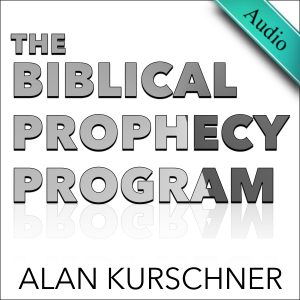Podcast: Play in new window | Download | Embed
 A fundamental presupposition of pretribulationism views the rapture event as disconnected from the second coming. Pretribulationism claims that the rapture occurs before Daniel’s 70th week begins, i.e. the seven-year period, while the second coming occurs after the seven years is complete. Thus, it necessarily disconnects the rapture from the second coming and is used as support for imminence.
A fundamental presupposition of pretribulationism views the rapture event as disconnected from the second coming. Pretribulationism claims that the rapture occurs before Daniel’s 70th week begins, i.e. the seven-year period, while the second coming occurs after the seven years is complete. Thus, it necessarily disconnects the rapture from the second coming and is used as support for imminence.
However, this pretrib presupposition is based on false premises and assumptions. Dr. Kurschner challenged this major presupposition that pretribulationists use to maintain imminence by pointing out a logical flaw.
While posttribulationism wrongly believes that the rapture and the second coming is the same event, pretribulationism commits the opposite error by claiming the rapture is disconnected from the second coming. But it is not either or. Rather, the rapture is part of the second coming of Christ, which will be one of the very first events that will occur during the second coming.
A frequent pretribulational mantra that is frequently stated in their literature goes something like this: At the rapture, Christ comes for his church, while at the second coming, he comes with his church. This conception is the basis for their claim that Jesus’s return will occur in “two stages” or “phases” being separated by seven years, the “rapture coming” and the “second coming” (parousia). To attempt to prove their point, they enumerate a set of supposed “contrasts” between these two events. The following table is typical of what you will find in pretrib books.
TABLE 1. Pretrib ‘Contrasts’ between the Rapture and Second Coming
| The Rapture Coming | The Second Coming |
| Jesus will come for his church | Jesus comes with his church |
| Jesus comes in the air | Jesus comes to the earth |
| Affects only believers | Affects unbelievers |
| Christ comes to reward | Christ comes to judge |
| There are no signs – imminent | There are signs – Not imminent |
| Christ gathers his church | Angels gathers Israel |
| A secret event for the church | A visible event for the world |
| Resurrection for the church | Resurrection for Old Testament saints |
| Tribulation begins | Millennium begins |
This juxtaposition of so-called contrasts may seem convincing on the surface. But it is distorted, prejudiced, and deeply flawed. It is a mistaken notion to separate the rapture from the second coming. The illogical nature of this presupposition is demonstrated in this episode using an absurdity to illustrate an absurdity.
In the following table, selected elements were taken from the gospels and in particular the Passion narrative in the life of Jesus and contrasted against each other to look like the are distinct and contradictory.
TABLE 2. Gospel and Passion Narrative ‘Contrasts’
| Event A | Event B |
| Messiah would be betrayed (Luke 22:48) | Messiah would be defended (John 18:10) |
| Messiah would be silent before his accusers (Mark 14:61) | Messiah would speak before his accusers (Mark 2:8–9) |
| Messiah wears purple clothing (John 19:5) | Messiah wears white clothing (Mark 9:3) |
| Messiah would be mocked (Luke 23:35) | Messiah would be worshipped (Matt 14:33) |
| Messiah’s feet would be pierced (Luke 24:40) | Messiah’s feet would be kissed (Luke 7:38) |
| Messiah would be forsaken by God (Matt 27:46) | Messiah would not be forsaken by God (Matt 26:53) |
| Messiah would be given vinegar to drink (John 19:29) | Messiah would drink wine (Matt 26:29) |
| A Soldier would pierce Messiah’s side (John 19:34) | A Soldier would confess Messiah as Son of God (Mark 15:39) |
In Table 2, if we follow the pretrib reasoning from Table 1, then we should also conclude that the Gospels portray two first comings of Jesus and Passion events! Selected events were taken within the first coming of Jesus especially from the Passion event of the gospels and contrasted them against each other to look as if there were two distinct, separate, and contradictory events (Event A vs. Event B). However, no one actually believes there were two separate first comings of Jesus and thus two Passion events.
A sound interpretive examination of the Passion narrative in the gospels, however, shows Events A and B are—not contradictory—but part of the same unified, complex-whole event. The elements in Table 2 were cherry picked in order to convey that there are two different first comings of Jesus and thus two Passions of Christ, which of course is absurd. Any interpreter can selectively pick elements and “contrast” them against each other to claim two separate events.
Logical reasoning is only as good as the premises they are built on. It is easy to create surface-level and artificial tables, but its another thing to substantiate conclusions based on sound interpretive principles and exegetical evidence.
The obvious point of this exercise of absurdity is to reveal that Table 1 is based on the same flawed, illogical reasoning, resulting in a flawed, selective, predetermined conclusion—therefore it is misleading. Their premises take Scripture out of context and wrongly pit elements against each other to reach a predetermined presupposition. To maintain the theological presupposition of imminence, it is necessary for pretribulationism to insist that the rapture is disconnected from the second coming. If it is admitted that the rapture belongs to the second coming then petribulationists should recognize that intervening events and signs will occur before the rapture, and consequently, the teaching of imminence then is rendered a fictitious construct lacking biblical support.


